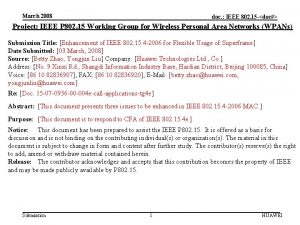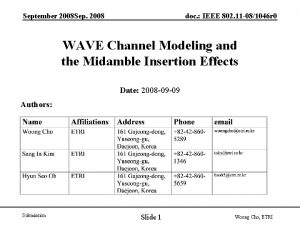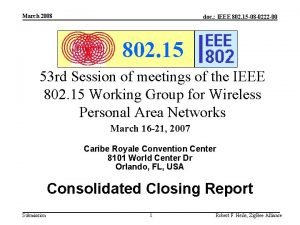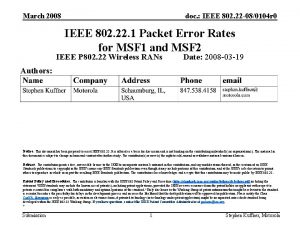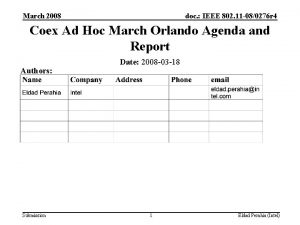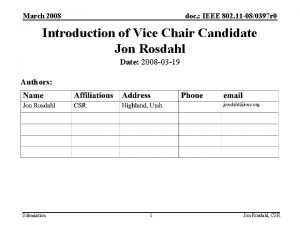March 2008 doc IEEE 802 11 08 On









- Slides: 9

March 2008 doc. : IEEE 802. 11 -08/ On the feasibility of 1 Gbps for various MAC/PHY architectures Date: 2008 -03 -17 Authors: Submission 1 Roberta Fracchia (Motorola)

March 2008 doc. : IEEE 802. 11 -08/ Abstract This analysis provides inputs on the technical feasibility of achieving 1 Gbps aggregated MAC SAP throughput for below 6 GHz amendment, by using different MAC layers which manage the access to different parallel channels Submission 2 Roberta Fracchia (Motorola)

March 2008 doc. : IEEE 802. 11 -08/ 802. 11 n MAC Throughput • Intel presentation 07/2431 r 0 shows that at least 160 MHz BW for 4 x 4 MIMO are necessary to reach 1 Gbps MAC throughput (corresponding to 2048 Mbps PHY rate) Throughput PHY rate Target MAC throughput 260 Mbps 520 Mbps 1040 Mbps 1560 Mbps 2080 Mbps 4160 Mbps 802. 11 n • Considering a single channel, whose access is managed by a single MAC, the MAC efficiency is ~64% for 1 Gbps PHY rate and ~40% for a PHY rate of 4 Gbps (5 STAs) Submission 3 Roberta Fracchia (Motorola)

March 2008 doc. : IEEE 802. 11 -08/ Multichannel CSMA MAC Throughput (Mbps) • Performance can be improved by the use of multiple channels: multiple CSMA channels perform better with respect to a single-channel CSMA in case of fixed aggregated bandwidth • Multi-channel CSMA protocols achieve higher performance than single channel ones since the MAC throughput doesn’t scale linearly with the PHY throughput: 3000 2 x 1000 If the total bandwidth B is divided in N channels of bandwidth BN=B/N, the maximum total MAC throughput is Throughput_Multi. Ch (B) = N ·Throughput (BN) > Throughput (B) 2000 1000 2000 PHY Throughput (Mbps) 3000 (As a first approximation PHY throughput for a given spectral efficiency scales linearly as a function of the bandwidth) • By allowing concurrent transmissions the number of collisions is also reduced, thus increasing the MAC throughput Submission 4 Roberta Fracchia (Motorola)

March 2008 doc. : IEEE 802. 11 -08/ Maximum MAC throughput with multiple channels Aggregated MAC Throughput (Mb/s) 1600 BN=20 MHz BN=40 MHz 1400 We evaluate the maximum throughput that can be achieved considering • AMSDU • TXOP=2 ms • Packet size = 1500 B • CW=15 • 64 QAM 5/6 • 3 users per channel 1200 1000 NSS= 4 800 NSS= 3 600 NSS= 2 400 200 0 40 50 60 70 80 90 100 Total bandwidth B (MHz) 110 120 To reach 1 Gbps throughput with 4 Spatial Streams: 100 MHz BW (with parallel channels) wrt 160 MHz BW (with a single channel) are required Submission 5 Roberta Fracchia (Motorola)

March 2008 doc. : IEEE 802. 11 -08/ Remarks • The finer the channel granularity, the higher the gain: 20 MHz channels are better than 40 MHz channels • 80 MHz BW: – 900 Mbps throughput with NSS=4 – 650 Mbps throughput with NSS=3 – 450 Mbps throughput with NSS=2 Aggregated MAC Throughput (Mb/s) • 100 MHz BW: – 1. 1 Gbps throughput with NSS=4 – 850 Mbps throughput with NSS=3 – 550 Mbps throughput with NSS=2 • 120 MHz BW: – 1 Gbps throughput with NSS=3 – 650 Mbps throughput with NSS=2 Submission 6 100 MHz BW 1200 1000 800 600 5 10 20 30 Number of users 40 Roberta Fracchia (Motorola)

March 2008 doc. : IEEE 802. 11 -08/ Architectural solutions for multiple CSMA (1/2) We assume that the total bandwidth B is divided in N channels of bandwidth BN=B/N 1. Each user has 1 radio, to access 1 of the N channels STA MAC • One MAC/PHY for each user • Many works in the literature proposing: – Channel hopping strategies – Synchronization and access methods – Use of a Control channel B BN PHY 2. Each user has N radios, one for each channel • A Multi-Radio Unification Protocol for IEEE 802. 11 Wireless Networks, A. Adya, P. Bahl, J. Padhye, A. Wolman, L. Zhou (Microsoft Research) STA MAC controller MAC MAC PHY PHY Submission • The access to the N channels given by N multiple wireless network cards (multiple MAC/PHY layers), coordinated by a MAC controller which: – presents a single MAC SAP to layers above – monitors the channel quality on each interface – selects the interface to forward the packet on 7 Roberta Fracchia (Motorola)

March 2008 doc. : IEEE 802. 11 -08/ Architectural solutions for multiple CSMA (2/2) We assume that the total bandwidth B is divided in N channels of bandwidth BN=B/N 3. Each user has multiple MACs but only one PHY layer • Multiple MACs, coordinated by a MAC controller, regulate the access to the N channels • A single PHY layer uses the total bandwidth: a single FFT is done on the bandwidth B STA MAC controller MAC MAC PHY • The use of different channels is allowed, with the same number of antennas used for a single channel bandwidth Submission 8 Roberta Fracchia (Motorola)

March 2008 doc. : IEEE 802. 11 -08/ Conclusions • Single channel bandwidth extension is not a suitable solution to match 1 Gbps throughput • Parallel channels can highly improve the MAC throughput • This stresses out the importance of introducing in VHT the support for multiple transmissions at the same time expanding on the multi-user dimension • 1 Gbps feasibility is provided with 5 channels of 20 MHz for NSS=4 (~40% of bandwidth gain compared to single channel) • 800 Mbps feasibility is provided with 5 channels for NSS=3 • 500 Mbps feasibility is provided with 5 channels for NSS=2 • But opens up new challenges to define the most suitable architecture for the access to parallel channels Submission 9 Roberta Fracchia (Motorola)










